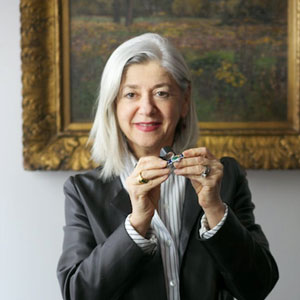
Auction house Skinner didn’t have a jewelry department until Gloria Lieberman started one in 1980.
Fast forward 39 years, and the Boston-based auctioneer is well-known for its excellent and creatively curated fine jewelry sales. All thanks to Lieberman, a frequent lecturer at schools such as FIT, Harvard, and the Rhode Island School of Design who serves on the vetting committee for Palm Beach antiques show.
Today at 12 p.m. the auction house hosts its Important Jewelry sale, featuring a glittering mélange of estate, branded vintage, and new jewelry. We caught up with Lieberman, a vice president at the company, to talk about the sale, how outside forces have changed the jewelry world since she’s been in it, and why we all need to stop thinking about our valuables as “investments.”
JCK: What are some standout pieces in this Important Jewelry sale?
Gloria Lieberman: We have the most beautiful Cartier twin sapphire stone ring (below). I mean, the reaction to it is stunning. It’s so simple, it’s taking two gemstones and putting them side by side and letting them beam at you. It’s just breathtaking. Most people won’t be able to afford it, but they need to see it. We’re all biting our nails waiting to see what it sells for.
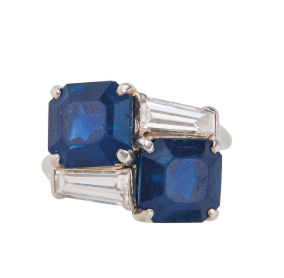
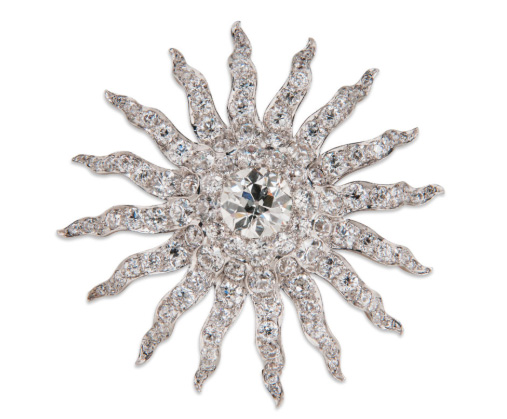
We also have a starburst diamond brooch (above). It’s the largest I’ve ever seen. It’s almost the exact size of Jackie O.’s sunburst, but it’s actually bigger. It comes from an important New England family where it’s been in the family since 1880, in the original box. We’re very excited about it.
The other thing is this quirky ring with a cabochon ruby that’s sort of pear-shape, and it probably was a bead that sat in a maharaja’s hat [below]. It’s Burmese, no heat, and it breaks all the rules. I described it to someone and they said, ‘I don’t want a flat-bottom ruby, etc.’ But when you see it, you want it.
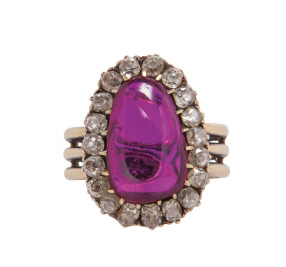
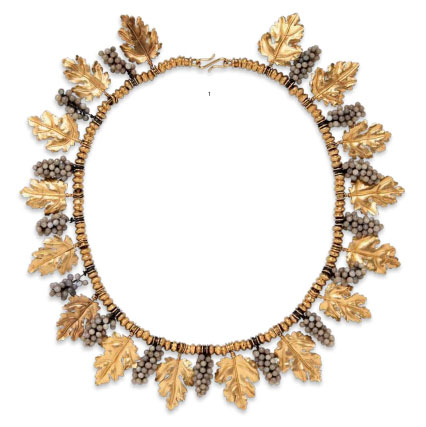
There’s also this incredible necklace from Italy’s Castellani that I love (above). It’s the first lot and is a necklace with these little white grapes hanging from it. The family selling it is just now coming back to the market after many years.
How did you ended up founding Skinner’s jewelry department?
I’ve been here 40 years. I started the jewelry department in September 1980. They didn’t have one, and Bob Skinner let me start it. I’ve trained many people in the industry…it’s a long history. I certainly didn’t start out as a jewelry person. I started out as a teacher in New York City. I taught English in Bedford-Stuyvesant [Brooklyn].
I liked jewelry. I didn’t know much about it, but it translates into the arts. To me jewelry was an art form. The history of jewelry is the history of fashion and art and the world—it’s one package. The pulls on a piece of furniture will tell you about the jewelry of that period. If you look at it as a total period, you understand design.
What have been the big changes in jewelry since you started?
Now it’s all very different. Certainly the internet is a disruptor. Everything is available—all information—even if it’s wrong. The internet allows you to buy visually, it doesn’t allow you to buy tactilely. To me that’s what’s important. Picking up a piece, turning it over, letting it talk to you.
When I’m training new people I always say, ‘Pick up the piece and let it speak to you. Maybe it’s a copy, maybe there’s been something that was broken and fixed. Let the piece breathe and speak.’ It’s a different approach.
And when you go into a room with someone [selling their jewelry], you’re almost a jewelry psychiatrist. It can be very hard for people to let go of their jewelry, so you let them tell you before you tell them. They have their own stories and opinions. They want to know, ‘Should I keep this? Should I sell this?’
Everyone now looks at everything as an investment. We have now gotten into this thing where we’re asking of everything, ‘Is it an investment?’ A bottle of wine, a pair of sneakers! C’mon. When everything has a dollar value on it, we forget the purpose of these things. You’re living in a house, you’re wearing sneakers, you’re inheriting a piece of your family in a piece of jewelry.
For those of us who are involved in the history of jewelry…it’s not commercial, it has heart. And when we get a wonderful old piece, you can see the old-time dealers still react to it in a different way. They’re thrilled.
Top: Gloria Lieberman, vice president of Skinner Auctioneers (all photos courtesy of Skinner)
- Subscribe to the JCK News Daily
- Subscribe to the JCK Special Report
- Follow JCK on Instagram: @jckmagazine
- Follow JCK on X: @jckmagazine
- Follow JCK on Facebook: @jckmagazine